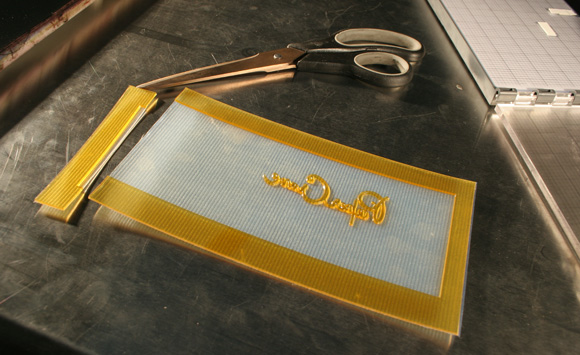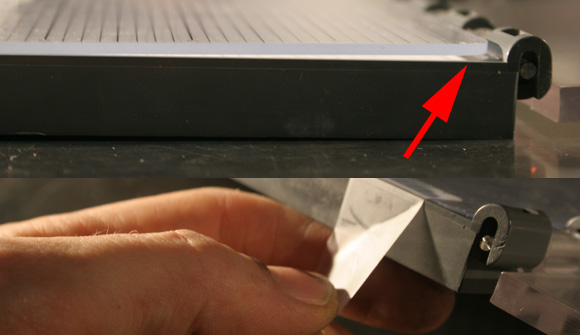Modern letterpress is all about the feel of those tactile, luxurious papers and the bite into the paper. With these attributes in mind, how do you make the decision of cotton or bamboo or 1-ply versus 2-ply?

While we do not sell letterpress paper here at Boxcar Press, we do have some nifty tips to help navigate your way through the sea of paper possibilities for your next letterpress printing project.
The Basics
Most letterpress papers are uncoated paper stock (a paper with no gloss or shininess to it). Most papers come in ivory or a shade or two of white from a bright white to a natural white. A paper with a nice texture that aligns with your overall project’s aesthetic is a good choice.
Papers sold are categorized by the overall weight of a ream of paper (or 500 sheets of paper) -“lbs“ refers to standard American English pounds and “gsm“ refers to metric grams/square meters.
A traditional 1-ply paper is usually 110lb or 300 gsm. A traditional 2-ply paper is usually 220lb or 600gsm. In comparison, printer copy paper for a copier or at-home inkjet printer is usually 20lb or 54gsm.
Where to start?
Whether you are a newcomer to the letterpress printing & paper world or a seasoned printer who is looking for a new paper, we heartily recommend (if possible) that you purchase or obtain paper samples. If you have a keen affection or interest in a certain paper company’s stock of papers, you will find most companies either sell paper swatch books for a reasonable price or, in certain cases, have free paper samples. We have compiled a list of papers for your musing and contemplation. (Note that these prices do not include shipping costs and are current pricing for the items themselves at the time of this post).
General directory of sample packs: visit the following sites for a wide variety of papers and envelopes.
- LetterpressPapers.com – samples range from $2 — $8
- Takach Paper Co – sample ring with most stocked papers $12
- Legion Paper – samples range from $2 — $20
- Staff Pick: Legion Paper’s Letterpress Selections is $8, and includes 22 different types of 3.5” x 5” paper samples, including Arturo, Colorplan, Rising Museum Board, Stardream, and Legion Bamboo, to name a few.

What letterpress papers to use?
There are major factors that influence what paper to use for a certain project. Factors may include: budget, thickness of paper for impression depth ability, impression aesthetic, and overall aesthetic. Determine what your projects needs are and research your paper to fit those needs. If you can shop around for pricing… we heartily support it to banish away those barren budget blues.
If you are aiming for a softer impression, try a cotton rag paper like Crane’s Lettra. For a soft but tighter fiber paper, try a bamboo paper or something with less than 100% cotton content (example: Cardenon papers have 20%-35% cotton content). Some might like the natural recycled content of a chipboard or kraftboard.
Don’t avoid handmade papers thinking they are out of the budget. There are paper vendors who make beautiful papers in many colors that are favorably priced and will add a “wow” to your project. Handmade papers, which are a unique style of paper all on its own, will usually have a distinct, pronounced texture or feel to the paper where there are minute differences from sheet to sheet. Think of each sheet as “sisters” – similar look but unique all on its own. Deckled edges (or the feathery edges you see on the edge of the paper) are common with handmade papers, although there are papers that do not have the deckled edge. You can cut off the feathered edge if you wish. This uniqueness is often sought after for custom projects.
Embrace and explore all the options and special papers available to you.
Paper Types
Crane’s Lettra: “soft and luxurious to the touch, yet strong and stable on press, the distinct, extra bulky “letterpress” finish of 100% cotton is rare in machine-made paper.” Crane’s Lettra is a staple for our commercially printed projects here at Boxcar Press as well.
- Neenah Paper offers your first swatchbook for free, each additional copy is $10.95. They also offer free paper swatches and envelopes – samples are available for Crane’s Lettra Pearl White, Crane’s Lettra Fluorescent White, and Crane’s Lettra Ecru.
- Legion Paper also offers Crane’s Lettra, with a sampler pack available for $5.

Cordenon’s Canaletto and Wild: “Italian paper-making art dating back four centuries with a touch of cotton, creating strength and beauty, durability and class.”
- Neenah Paper offers your first swatchbook for free, each additional copy is $14.95.

Fabiano Colored Paper and Fabiano Artistico White Rag: An Italian paper mill creates this luxurious soft, cotton-based paper that has a modified cold-pressed surface texture that provides an intriguing paper feel.
- Available through the “Watercolor Paper Sampler” pack from Legion Paper for $12.

(photo courtesy of Holyokedirect.com)
Holyoke cotton papers: A soft paper cotton-based paper with a smooth feel and a good alternative to consider for wedding invitations and similar pieces.
- A sample set is available through Holyoke Fine Papers and Supplies for $7.70 per pack.
Legion’s bamboo paper: This bamboo paper has a tighter fiber weave and is great for business cards.
- Samples of Legion’s bamboo can be found through Legion Paper (pick up a swatchbook with paper and envelope samples for $5) and LetterpressPaper.com – paper and envelope samples start at $5.
Moab Entrada: A 100% cotton smooth fine art paper that is acid- and lignin-free paper.
- Two sheets of 8.5″ x 11″ Entrada are included in Moab Paper’s sample box, which sells for $26.48 and includes a variety of other fine art papers. Legion Paper also sells a sampling of thirty 8.5″ x 11″ sheets of various Moab papers for $25.98.

Mohawk Paper: Superfine is a beautiful paper with lush tactility, smooth texture surface and great for all-around projects. The Strathmore Pure Cotton line provides a crisp texture and beautiful wove finish.
- Mohawk offers swatchbooks for all of their papers, and prices range from $4.99 – $12.99.

Reich Savoy: “blends old world elegance with new world sophistication making it the perfect choice for a wide range of projects from greeting cards and invitations to hang tags and luxury packaging.”
- Reich Paper offers a swatchbook for $5.95.

Revere: A luxe and super soft paper that is meant to be held and is perfect for wedding invitations or a card that begs to be touched.
- A 2″ x 6″ matchbook sample of Revere paper is available through Legion Paper for $0.99.
Rives BFK: “100% cotton and no optical brightening agents, it is a bright white, smooth, soft and pliable sheet.”
- Samples of Rives BFK paper is included in Legion Paper’s Letterpress Selections pack for $12.
Somerset: A soft-handling paper with a supple surface texture. Good for wedding invitations or business cards calling for a softer impression or feel.
- A mill book containing thirty 5” x 5” sheets is available for $7.50 from Legion Paper.
Arturo papers: A mouldmade soft, luxurious paper that comes in a variety of colors with matched envelopes available.
- You can purchase ten 8.5″ x 5.5″ sample sheets through LetterpressPapers.com for $6.
Chipboard and Kraftboard: A thick, heavy weight of paper board that is great for hangtags and coasters.
- French Paper offers a $5 sample pack that includes every color and weight from their Kraft-Tone line.
Where do I purchase letterpress paper?
Brick-and-mortar stores
- A local fine arts supply store – you may have to special order papers if the store does not carry the papers on the shelf.
- Michael’s – may carry small quantity packs or specific papers may be special-order items.
- Utrecht – carries a variety of fine papers, including Rives BFK, Moab Entrada, and Lenox 100%.
Online stores
- LetterpressPaper.com – a great variety of paper selected for letterpress printing with many different varieties in a multitude of colors.
- Paper-Papers – another great online paper source with many papers in various sizes. We recommend their “Cotton Papers” for letterpress projects.
- Paperworks – offers letterpress paper options with matching envelopes, including several FSC-certified papers.
- Hiromi Paper – specializes in Japanese papers, but is also a good source for Arturo and Fabriano papers, postcard weight paper stock, and deckle-edge papers.
- Porridge Papers – nice papermakers who make a great variety of handmade paper.
- Legion Paper – use Legion’s ultimate paper selector to help narrow down your many options.
- Crane – purchase Crane Lettra papers in a variety of weights and colors, with various envelope options to match.
- Twin Rocker – offers handmade papers (check out their swatch set for samples).
- Botanical Paper Works – specializes in handmade papers that are embedded with wildflower, vegetable, or herb seeds that can be planted later on (they offer a seed paper swatchbook for $10).
- French Paper – produces over 100 stock colors in multiple weights and textures, including kraft papers.
- Paper Mart – also offers chipboard or kraft papers.
Looking for a new luxurious cotton stock paper to try out for your next project? We carry Flurry Paper in our online store here! Available in three colors, three weights as well as envelopes and cards!
We hope that this essentials list of paper energizes you to search out and try something new for your next project. As always, let us know in the comments section below how you fared and any suggestions to our list that helped you out. We’d love to hear from you!































